Friday Mosque of Sojas: different from what you have already seen!

TEHRAN - Full of mystic but modest in size and architecture, the Friday Mosque of Sojas was built sometime in the early 12th century during the Seljuk era.
The mosque is located approximately fifty-six kilometers south of Soltaniyeh in northwestern Iran. Although no date is mentioned in any of the inscription friezes found in the mosque itself, the articulation of its brick structure and decoration indicates that its approximate construction date has been determined to be around 1100.
Three elements are most prominent in the overall shape and design of the ancient mosque: a large square chamber, a dome, and the transition between the two. In plan, the square-shaped mosque is oriented towards the qibla, approximately north-south. It is entered from the north through an opening in the center of the elevation, directly opposite the mihrab in the center of the southern wall.
Typical of Seljuk structures, most of the decoration of the interior is achieved with brickwork patterns. Diamond-shaped brickwork patterns can be seen below the inscription band at the top of the cubic volume and on the surfaces between the arches and squinches in the zone of transition.
Some travel insiders say that for many avid sightseers, it could be a rewarding, unmatched experience; different from what they have already visited!
According to Archnet, the structure is symmetrically organized with two large pointed arch window openings at the edges of each of the lateral walls and a single large entrance opening, also a pointed arch on the northern elevation.
Four small window openings pierce the dome above, at the center of each of the sides. Further emphasizing the symmetry of the interior, at either side of the entrance and on either side of the mihrab, the surfaces are decorated with a shallow inset arch with small muqarnas above it and a diamond-shaped pattern on its surface. Each of these is set within a rectangular frame with a floral and vegetal pattern carved in the brick on either side of the arch.
The mihrab is also set within a larger rectangular frame with a perimeter inscription band that is rounded in section and a second band with a floral design. Within these two bands fits a semi-vault that is recessed within the wall of the square chamber. At the center of this and smaller in scale is an arch that is further recessed in the wall of the structure. An earlier, narrower mihrab can be seen through the gaps where stucco has broken off the existing mihrab. The use of pigment and plaster found in the existing mihrab imply that it was built later, ca. 1295-1300 when these materials were commonly used.
In addition to the inscription band outlining the mihrab, there are two more inscription bands found in the interior of the mosque, both dating from the beginning of the 12th century. One inscription band follows the perimeter of the top edge of the cube volume, while the other encircles the perimeter at the base of the dome. Between the two inscription bands is the transition of the square to circle. The transition of the cube base to the dome of a smaller diameter above is achieved by large squinches at the corners. Above the inscription, frieze is a row of four large squinches, one at each of the corners, and four squat pilastered pointed arches between these, located at the center of each of the sides. Above this is yet another row of sixteen smaller squinches which further reduces the square to a circular form. The dome sits on a perimeter band of brick above these squinches.
Soltaniyeh is an ancient city in the west-central Zanjan province. Meaning “Town of the Sultans”, it was briefly the capital of Persia’s Ilkhanid dynasty (a branch of the Mongol dynasty) during the 14th century.
The city, which is home to many historical structures, sites, and monuments including the UNESCO-designated Dome of Soltaniyeh, which is the highlight of the city’s tourist attractions.
AFM

Leave a Comment